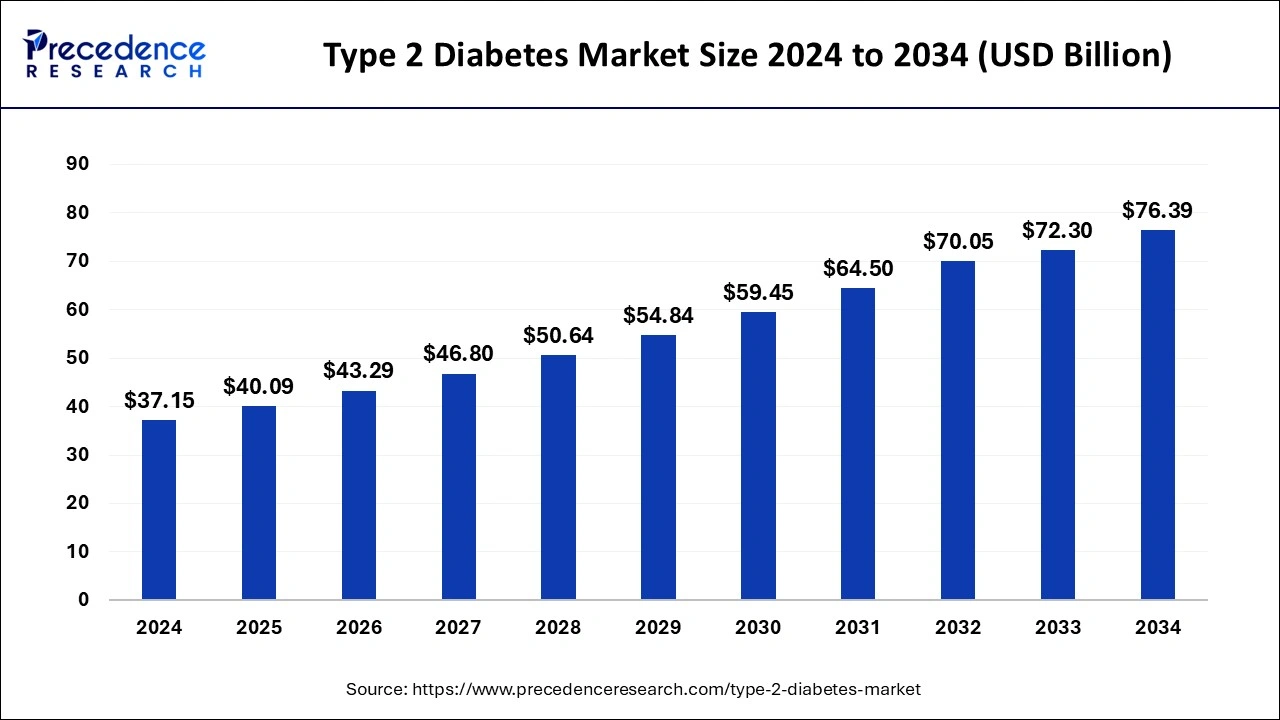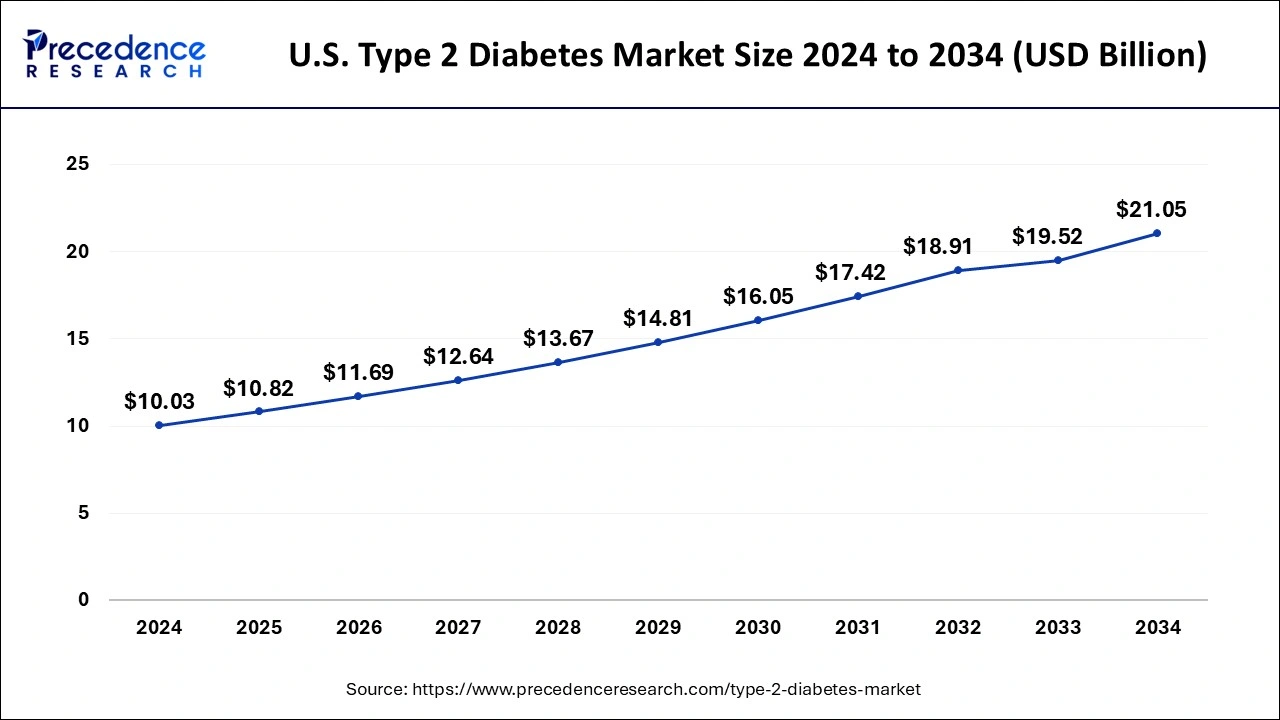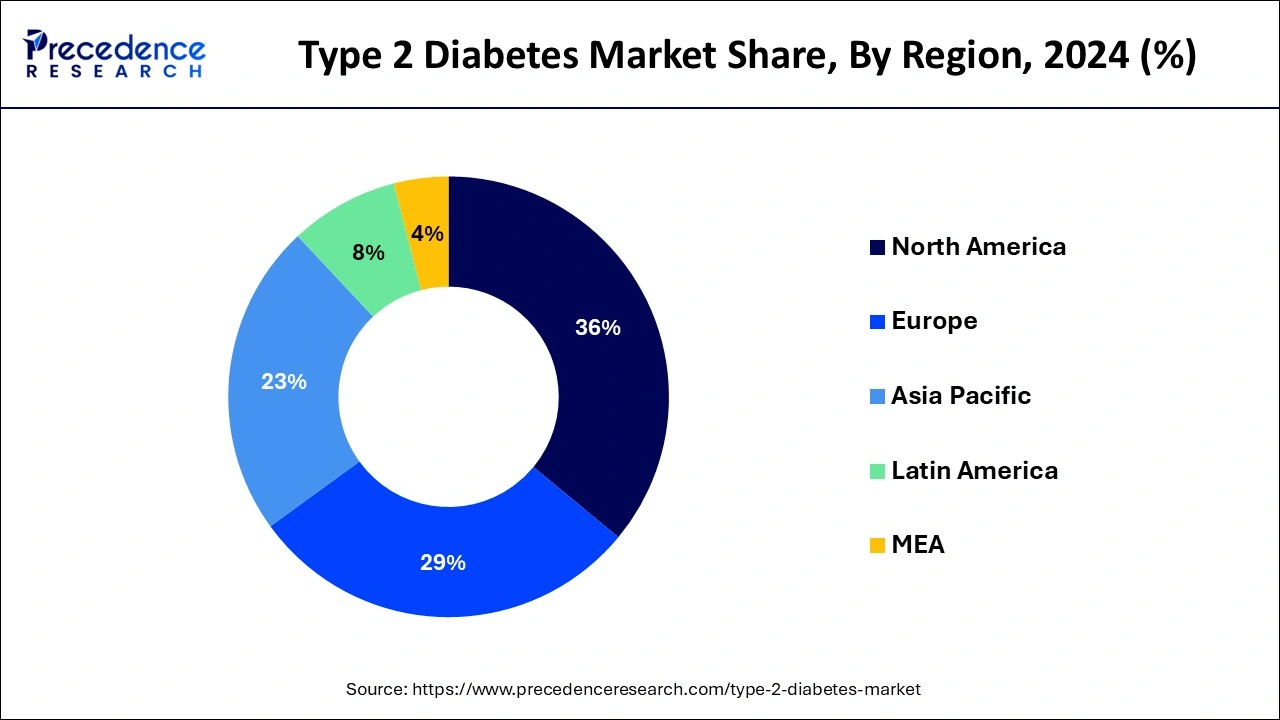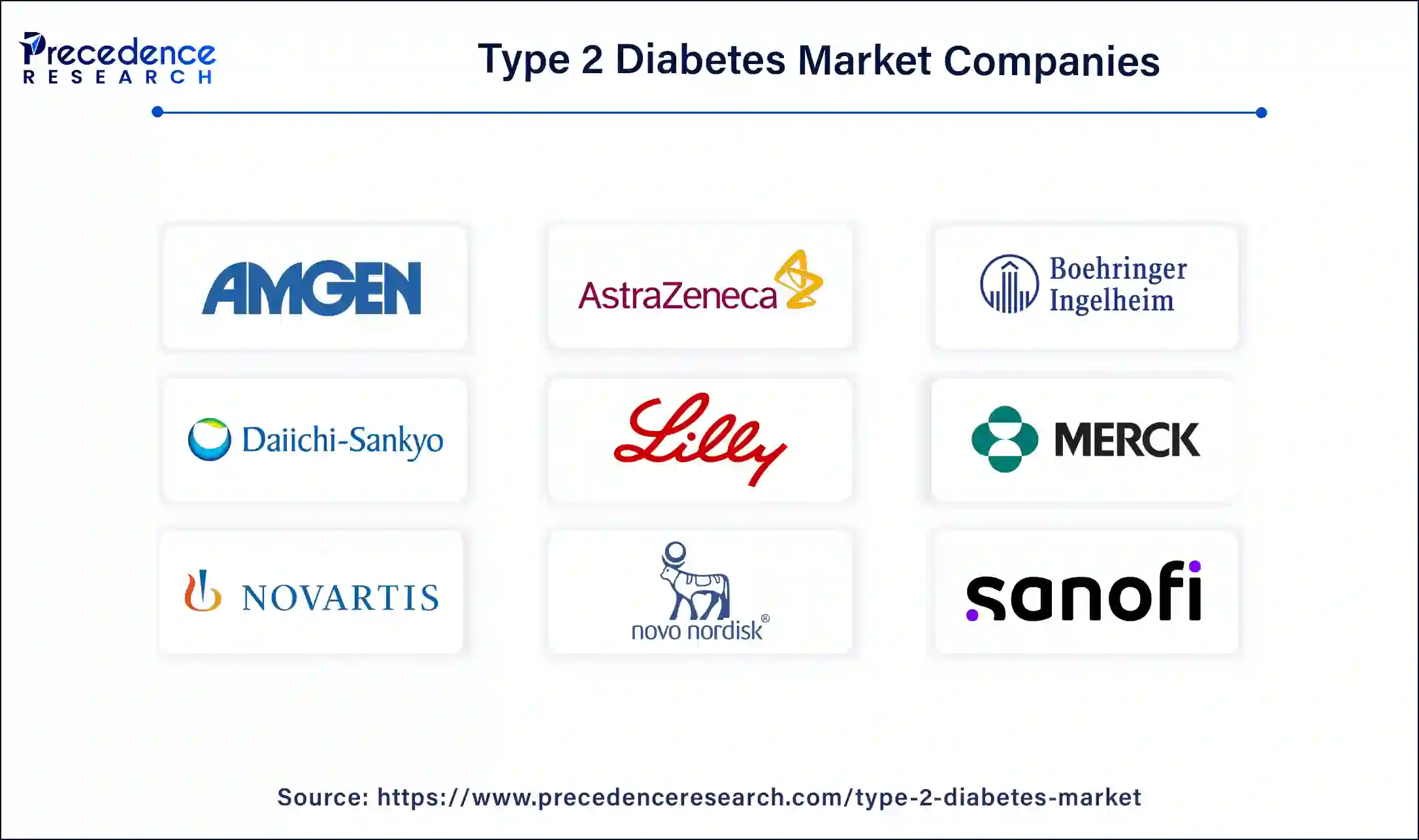November 2024
The global type 2 diabetes market size is calculated at USD 40.09 billion in 2025 and is forecasted to reach around USD 76.39 billion by 2034, accelerating at a CAGR of 7.47% from 2025 to 2034. The North America type 2 diabetes market size surpassed USD 13.37 billion in 2024 and is expanding at a CAGR of 7.62% during the forecast period. The market sizing and forecasts are revenue-based (USD Million/Billion), with 2024 as the base year.
The global type 2 diabetes market size was accounted for USD 37.15 billion in 2024 and is anticipated to reach around USD 76.39 billion by 2034, growing at a CAGR of 7.47% from 2025 to 2034. The rising prevalence of type 2 diabetes, technological advancements, and growing research and development boost the type 2 diabetes market.

The advent of advanced technologies such as artificial intelligence (AI) and machine learning (ML) has transformed the healthcare sector. In type 2 diabetes, AI and ML play a crucial role in every aspect from diagnosis to treatment. AI and ML also have huge potential in the research field to develop novel anti-diabetic drugs resulting in increased effectiveness and reduced side effects. They are also used to identify potential drug targets involved in the complexity of the disease. Additionally, AI and ML are used to screen large amounts of patients for their diabetic presence. This reduces a lot of time and costs for government and private organizations. AI-enabled sensors enable patients to check their blood glucose levels frequently, without visiting pathology labs.
The U.S. type 2 diabetes market size was evaluated at USD 10.03 billion in 2024 and is predicted to be worth around USD 21.05 billion by 2034, rising at a CAGR of 7.69% from 2025 to 2034.

North America dominated the global type 2 diabetes market with the largest market share of 36% in 2024. The growth of type 2 diabetes market in the region is being driven by the growing prevalence of diabetes. Diabetes affects more than 29 million people in North America, with that number anticipated to rise to 32 million by 2025. In 2019, the U.S. alone had over 25 million diabetic sufferers. The factors such as expansion of healthcare sector and favorable government regulations are driving the growth of North America type 2 diabetes market. In addition, growing number of initiatives by government and favorable reimbursement policies are boosting the type 2 diabetes market growth in the region.

Asia Pacific is expected to expand at a solid CAGR during the forecast period. The UK dominates the type 2 diabetes market in Europe region. The growing number of type 2 diabetic patients is driving the growth of type 2 diabetes market in Europe region. The factors such as rising research and development activities as well as rising prevalence of obesity are propelling the demand for type 2 diabetes drugs. In addition, improved supply chain management is providing lucrative opportunities for the expansion of Europe type 2 diabetes market.
| Report Coverage | Details |
| Market Size in 2025 | USD 40.09 Billion |
| Market Size by 2034 | USD 76.39 Billion |
| Growth Rate from 2025 to 2034 | CAGR of 7.47% |
| Largest Market | North America |
| Base Year | 2024 |
| Forecast Period | 2025 to 2034 |
| Segments Covered | Drug Class, Application, Geography |
| Regions Covered | North America, Europe, Asia-Pacific, Latin America, and Middle East & Africa |
Generic Alternatives
The major growth factor of the type 2 diabetes market is the development of generic alternatives to popular brand drugs. Pharmaceutical and biopharmaceutical companies manufacture generics to increase the widespread accessibility and affordability of type 2 diabetes drugs. Generics are relatively cheaper as they do not undergo preclinical and clinical testing as well as avoid marketing costs. The favorable regulatory frameworks by regulatory agencies also support the development of generics. The increasing number of patent expirations facilitates generic development, leading to a drug with a similar safety and effectiveness profile.
High Treatment Cost
The type 2 diabetes market faces formidable challenges including the high cost of medical treatments. Advanced diagnostic tools and newer-brand drugs are very expensive and cannot be afforded by a larger population.
Growing Research and Development
The future of the type 2 diabetes market is promising, driven by growing research and development (R&D) activities. The R&D activities are strengthened by increasing investments and public-private partnerships globally. The growing demand for point-of-care diagnostics leads to the development of novel devices for diagnosing type 2 diabetes in the comfort of the patient’s homes. Needle-free devices increase accessibility to many people. Novel protein targets are investigated to design drugs targeting such proteins, treating type 2 diabetes from its root cause. The latest innovations are also made in revolutionizing the drug delivery systems to aid in targeted and timely drug delivery.
The government all around the globe is taking constant efforts for the development of global type 2 diabetes market. The government bodies are collaborating with major market players for the launch of new products in the worldwide type 2 diabetes market. In addition, government of emerging nations are providing tax benefits such as tax incentives and subsidies to the manufacturers of type 2 diabetes drugs and medications. Thus, all these factors are driving the growth and development of global type 2 diabetes market.
The market players are not only introducing new drugs and medicines, but also introduced devices and tools that can be utilized for the treatment and diagnostics of type 2 diabetes. Thus, the growing research and development activities are propelling the growth of global type 2 diabetes market. The market players as well as government are heavily investing for research and development initiatives. Thus, this factor is contributing towards the growth and expansion of global type 2 diabetes market.
The global type 2 diabetes market has sparkled a surge in interest nowadays, owing to the fact that it is the major reason for cardiovascular diseases, as well as a variety of renal and neurological problems. Another factor that is supporting industry to generate the most money is the growing obesity epidemic in many regions of the world. Furthermore, rising demand for diabetes medications among adults is boosting the growth of global type 2 diabetes market. Impaired glucose tolerance, gestational diabetes, and impaired fasting glycemia are three more components of type 2 diabetes. Thus, the growth of global type 2 diabetes market is expected in near future.
The insulin segment dominated the type 2 diabetes market in 2024. The increasing prevalence of diabetes cases in the population in which there is number of people suffering with type 2 diabetes which drives the demand for insulin as the major drug on a regular basis. Insulin is the major prescribed drug for type 2 diabetes mellitus. There are some types of insulin which are used by the type 2 diabetes patient such as a long-acting or intermediate-acting insulin, rapid-acting or short-acting insulin, and a mixed insulin (biphasic insulin) which contain intermediate and rapid-acting or short-acting insulin. The increasing intervention by the leading pharmaceutical firms in the development of the insulin drugs is further contributing to the growth of the segment.
The SGLT2 inhibitors is seen to grow at a significant rate in the market during the predicted period. The SGLT2 (Sodium-glucose Cotransporter-2) inhibitors offer the diversity in the medication it includes the nonglycemic and glycemic help in managing the diabetes level of number of diabetic patients. It helps in enhancing the glycemic control and reduces the cases like heart failure and progression of renal disease. The increasing cases of type 2 diabetes in the population and the demand for the efficient drug that can manage diabetes boosts the demand for the segment.
The oral segment led the type 2 diabetes market in 2024. The rising implementation of oral routes of administration of type 2 diabetes drugs for managing their blood sugar level in regular basis driving the demand for the oral drug segment. It is prescribed for the patient with diabetes but still produces insulin in the body naturally. Alpha-glucosidase inhibitors, Biguanides, Bile acid sequestrants (BASs), Dopamine-2 agonists, DPP-4 inhibitors (gliptins), Meglitinides (glinides), SGLT2 inhibitors, Sulfonylureas, and Thiazolidinediones (TZDs) are some types of oral diabetes medication.
The subcutaneous segment expects a notable growth in the market during the forecast period. The increasing awareness regarding the subcutaneous administration of drug owing to its benefits like the rapid effects in management of the blood sugar level. The subcutaneous routes of administration is the process in which the person with diabetic gets insulin injections in the abdomen, upper arms, thighs, and buttocks. The insulin injections prescribed to the patient do not produce natural insulin into the body due to the enzymes present in stomach destroying the insulin before it reaches to the bloodstream.
The retail pharmacies segment accounted for the largest share in the type 2 diabetes market in 2024. The easy availability of the retail pharmacies in the area, ease of reach, and availability of wide range of medications under the one roof is driving the growth of the segment. Retail pharmacists provide comfort and ease in buying medication, they also offer advice for a healthy lifestyle, correct type of insulin, needles, pens, and steps to use them. The retail pharmacies are equipped with all the essential and important type of type 2 diabetes mellitus treatment drugs and guidance related to managing the diabetes which enhance the customer experience.

By Drug Class Insights
By Route of Administration Insights
By Distribution Channel Insights
By Geography
For inquiries regarding discounts, bulk purchases, or customization requests, please contact us at sales@precedenceresearch.com
No cookie-cutter, only authentic analysis – take the 1st step to become a Precedence Research client
November 2024
May 2024
August 2024
February 2024